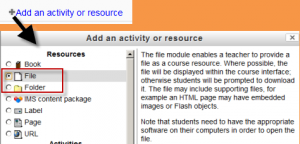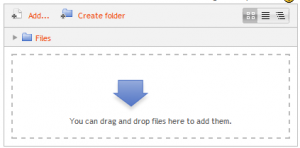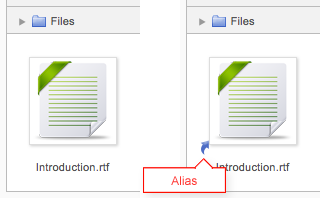Diferencia entre revisiones de «Trabajando con archivos»
De MoodleDocs
m (fix typo in link) |
(tidy up) |
||
| Línea 7: | Línea 7: | ||
==Añadiendo archivos== | ==Añadiendo archivos== | ||
To add files to a Moodle course, you must first ensure you have the editing turned on | |||
. | |||
===Arrastrar y soltar=== | |||
*If you are using a modern browser, you can simply click, hold and drag and drop a file directly onto your course page. You will know if drag and drop is available to you because you will (briefly) see a message at the top of your screen: | |||
[[File:dragdropmessage.png]] | |||
To drag and drop a folder, you must first compress/zip it using whichever program your computer has. | |||
===Añadir un recurso o actividad=== | |||
*Instead of drag and drop, you can click the link 'Add an activity or resource' and select either [[File]] or [[Folder]] from the activity chooser (or choose from the 'Add a resource' drop down menu, if this is present instead. | |||
{| | {| | ||
| Línea 14: | Línea 23: | ||
|} | |} | ||
*The screen for uploading and displaying a file (or folder of files) includes an "add" button. Clicking on this button takes you to the [[ | *The screen for uploading and displaying a file (or folder of files) includes an "add" button. Clicking on this button takes you to the [[File picker]] which is the name given to the file storage and access area within Moodle. Find out more about the places you can upload or add files from in the [[File picker]] page. | ||
*There is also a block (with an arrow) into which you can drag and drop a file straight from your desktop into Moodle.(Note that this currently doesn't work with Internet Explorer.) | *There is also a block (with an arrow) into which you can drag and drop a file straight from your desktop into Moodle.(Note that this currently doesn't work with Internet Explorer.) | ||
| Línea 20: | Línea 29: | ||
| [[File:newdraganddrop.png|thumb|Area for dragging and dropping files into]] | | [[File:newdraganddrop.png|thumb|Area for dragging and dropping files into]] | ||
|} | |} | ||
==Viendo los archivos subidos== | ==Viendo los archivos subidos== | ||
| Línea 27: | Línea 35: | ||
{| | {| | ||
| [[File:truthumbnailsiconsview.png|thumb| | | [[File:truthumbnailsiconsview.png|thumb|File picker icon view]] | ||
| [[File:tableview.png|thumb| | | [[File:tableview.png|thumb|File picker table view]] | ||
| [[File:hierarchicallistview.png|thumb| | | [[File:hierarchicallistview.png|thumb|File picker hierarchical list view]] | ||
|} | |} | ||
| Línea 42: | Línea 50: | ||
==Creando un alias/atajo== | ==Creando un alias/atajo== | ||
*When an uploaded file | *When an uploaded file - or a file from the Private files, Dropbox, File system or EQUELLA repositories - is re-used elsewhere on Moodle, the teacher has the option to make a copy (a new, unconnected version) or to create a shortcut or ''alias''. (Note: Previously an alias could be made to a file stored in Box.net, however with [[Box.net APIv1 migration |Box.net API v2]] this is no longer possible.) | ||
*If an alias is created, then when the original file is updated, it will change in all instances of the alias. So a teacher might add course notes to their private files for example, and then add them into a number of courses. When the teacher makes an alteration in the file in their private files, this alteration will be reflected in all instances of the course notes. | *If an alias is created, then when the original file is updated, it will change in all instances of the alias. So a teacher might add course notes to their private files for example, and then add them into a number of courses. When the teacher makes an alteration in the file in their private files, this alteration will be reflected in all instances of the course notes. | ||
*An alias can be recognised by its thumbnail. See the difference in the screenshot below between the original file (left) and the alias (right): | *An alias can be recognised by its thumbnail. See the difference in the screenshot below between the original file (left) and the alias (right): | ||
| Línea 68: | Línea 76: | ||
==Vea también== | ==Vea también== | ||
* | *HQ Youtube video tutorial: [https://www.youtube.com/watch?v=Vr41LtX8Mlc&index=21&list=PLxcO_MFWQBDdQjcGsbROYKwEIM-IlXmpR Dragging and dropping files into Moodle] | ||
* | *HQ Youtube video tutorial: [https://www.youtube.com/watch?v=07MpjfRIpXY&list=PLxcO_MFWQBDdQjcGsbROYKwEIM-IlXmpR&index=21 Uploading files to Moodle] | ||
* | *Cómo compartir un solo archivo con estudiantes: [[Archivo]] | ||
*Cómo compartir con los estudiantes una carpeta con archivos: [[Carpeta]] | |||
*Preguntas acerca del Selector de archivos: [[Selector de archivos FAQ]] | |||
* [[Restaurar alias de archivo]] | * [[Restaurar alias de archivo]] | ||
*[http://www.youtube.com/watch?v=IrOKxYRJvGU How teachers upload files in Moodle 2 video] | *[http://www.youtube.com/watch?v=IrOKxYRJvGU How teachers upload files in Moodle 2 video] | ||
| Línea 79: | Línea 89: | ||
Vea [https://docs.moodle.org/ | Vea [https://docs.moodle.org/27/en/Working_with_files Trabajando con archivos (en inglés)] | ||
Revisión del 16:40 11 jun 2014
Moodle 2.x
Nota: Pendiente de Traducir. ¡Anímese a traducir esta página!. ( y otras páginas pendientes)
- Moodle provides an easy way for a teacher to present materials to their students. These materials may take the form of files such as word-processed documents or slideshow presentations. The materials can be displayed on the page either as individual items or bundled together inside folders. One teacher might for instance wish to share a single research document in pdf format; another might have a folder of sample past examination papers for students to download.
- Most types of files can be uploaded and accessed through Moodle but the student needs to have the correct software to be able to open them.
Añadiendo archivos
To add files to a Moodle course, you must first ensure you have the editing turned on .
Arrastrar y soltar
- If you are using a modern browser, you can simply click, hold and drag and drop a file directly onto your course page. You will know if drag and drop is available to you because you will (briefly) see a message at the top of your screen:
To drag and drop a folder, you must first compress/zip it using whichever program your computer has.
Añadir un recurso o actividad
- Instead of drag and drop, you can click the link 'Add an activity or resource' and select either File or Folder from the activity chooser (or choose from the 'Add a resource' drop down menu, if this is present instead.
- The screen for uploading and displaying a file (or folder of files) includes an "add" button. Clicking on this button takes you to the File picker which is the name given to the file storage and access area within Moodle. Find out more about the places you can upload or add files from in the File picker page.
- There is also a block (with an arrow) into which you can drag and drop a file straight from your desktop into Moodle.(Note that this currently doesn't work with Internet Explorer.)
Viendo los archivos subidos
- Once uploaded, files appear as thumbnails in the file manager for easy recognition.
- Files view can be easily toggled between icons view or a table view with sizes and dates, or a hierarchical list view.
Editando o actualizando los archivos subidos
- Clicking on the name of an uploaded file opens up a pop up dialogue box which allows file details quickly to be altered.
Creando un alias/atajo
- When an uploaded file - or a file from the Private files, Dropbox, File system or EQUELLA repositories - is re-used elsewhere on Moodle, the teacher has the option to make a copy (a new, unconnected version) or to create a shortcut or alias. (Note: Previously an alias could be made to a file stored in Box.net, however with Box.net API v2 this is no longer possible.)
- If an alias is created, then when the original file is updated, it will change in all instances of the alias. So a teacher might add course notes to their private files for example, and then add them into a number of courses. When the teacher makes an alteration in the file in their private files, this alteration will be reflected in all instances of the course notes.
- An alias can be recognised by its thumbnail. See the difference in the screenshot below between the original file (left) and the alias (right):
Áreas en las que no se pueden hacer alias
An alias cannot be made in the following areas of Moodle:
- an assignment submission
- a forum post attachment
- a workshop submission
- a quiz essay
- a database activity file field
This is to prevent cases such as a student uploading an item for assessment and then subsequently changing the original in their private files. When a student uses a file from their private files in one of these instances, they do not see the options to "copy" or "create an alias". Below is an example of a file added to an assignment:
Vea también
- HQ Youtube video tutorial: Dragging and dropping files into Moodle
- HQ Youtube video tutorial: Uploading files to Moodle
- Cómo compartir un solo archivo con estudiantes: Archivo
- Cómo compartir con los estudiantes una carpeta con archivos: Carpeta
- Preguntas acerca del Selector de archivos: Selector de archivos FAQ
- Restaurar alias de archivo
- How teachers upload files in Moodle 2 video









